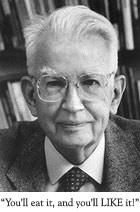Dan Klein has an excellent essay at Cato Unbound arguing (inter alia) that the distinction between coercion and voluntary agreement should occupy a central place in economic analysis:
Now, you might be muttering, “Yeah, whatever, but I’m interested in economics. I don’t care to ponder semantic issues about moral and political terminology. Let’s leave that to the philosophers.”
Hold on. We need the distinction between voluntary and coercive action to give meaning to “the free market.” We need it to identify an “intervention.” We need it to measure “economic freedom.” We use it to categorize classes of action, to identify and define industries, to formulate theoretical parallels between one industry and another, and between one polity and another. We use it to formulate reform proposals. Our theories about human interaction make key distinctions based on whether the interaction is voluntary. We generally assume that the individual is bettering his situation in voluntary interaction, but we don’t make the same assumptions in coerced interaction. The distinction between voluntary and coercive is built into many of the key analytic distinctions we use in economics. So it is important that we know what we mean by it.
The danger, as Klein acknowledges, is that focusing on coercion versus voluntarism might encourage more ideological – and thus less analytical – analysis. But the solution is to recognize forthrightly that “coercive” does not equal “always wrong.” It should be perfectly acceptable and comprehensible for an economist, even a libertarian one, to say of a particular policy that it is “coercive but still desirable on net.” For libertarian economists, such cases will be few; for other economists, they might be numerous. But at least we’d be on the same semantic page.
I strongly agree with the overall point, but I think Klein exaggerates the sharpness of the concept of coercion. He defines coercion as “when someone brings physical aggression or threat thereof to your property,” and he defines property as “your stuff, including your person.” Klein admits to the existence of holes and gray areas, but still says “the basic ideas of tangible property, ownership, and consent are cogent and apply so widely that we may think of the exceptions as exceptions.”
Okay, maybe I’m just arguing over how large those holes and gray areas are. But the problem, as I see it, is that many disputes concern exactly what your property is to begin with. Let’s take what Klein regards as one of the few cases where coercion by private actors is routinely tolerated: “loud Harley-Davidsons.” Is this example so obvious? Yes, the Harleys impose noise pollution on nearby homes; this is a kind of negative externality. But as Ronald Coase observed, externalities are reciprocal in nature. To side with the motorcyclists is to harm the home owners – but to side with the homeowners is to harm the motorcyclists. The real question is, what does your home ownership really include? A right to absolute silence? Surely not. But then how many decibels is too much? Does it matter if the motorcyclists had been cycling in your area long before the homes were built? (Or for a more contentious example, does it matter if the airport was built before the nearby homes were constructed under its flight path?) The issue here is not one of coercion versus voluntarism, but of establishing initial property rights.
Klein may have intended the Harley example as a jest. But his more serious example of grazing rights in Montana, where the presumption is that others’ cattle may graze on your land unless you specifically fence them out, suffers from a similar problem. The question again is what rights you really possess in what is otherwise your land. Just as it’s not obvious that you have a right to absolute silence in your home, it’s not obvious you have an absolute right not to have others' animals wander across your yard. Even outside Montana, you don’t need permission in advance to possess animals that might escape and do damage to someone else’s assets – you merely have to pay for any damage after the fact. In other words, land is protected against trespass by animals with a liability rule rather than a property rule. Is Klein saying that all liability rules constitute a form of coercion? If so, that would mean almost the entirety of tort law is an exercise in coercion – which would seriously damage his claim that institutionalized coercion by private parties is “almost never tolerated.”
For these reasons, I would restrict the term “coercion” to two types of cases: (a) Where there is general agreement on initial property rights, and then some action (public or private) takes away those property rights and transfers them to someone else. (b) Where there is general agreement on initial property rights, and then some action (public or private) prevents the owners of those rights from voluntarily transferring them.
This more restrictive definition of coercion would not rob it of all meaning. Taxation clearly falls within category (a), since there is general agreement that your income (or whatever else is being taxed) is indeed yours to begin with, even if it “becomes” the government’s. The minimum wage – Klein’s starting point in this discussion – would clearly fall in category (b), since there is general agreement that workers own their labor and employers own their money and their businesses, yet the law prevents these parties from making voluntary exchanges at mutually agreeable prices. Most of the policies that Klein lists, from drug prohibition to FDA regulations to gun control, would fall into either (a) or (b) or both. And, as Klein indicates, recognizing these as forms of coercion does not necessarily mean opposing them.
Read More...
Summary only...



